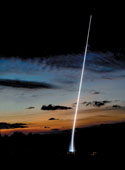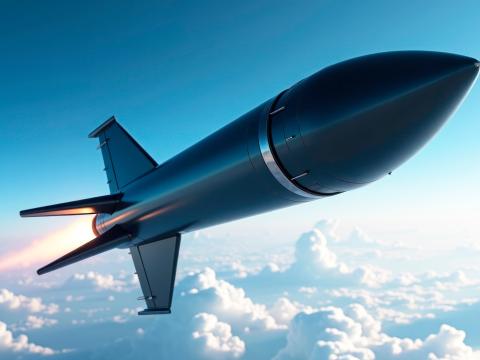 |
| A terminal high-altitude area defense (THAAD) interceptor blasts off into the night sky during a test last year. The United States has begun fielding several different ballistic missile defense technologies, some of which may be extended to protect allies. |
As enabling technologies mature, the threat becomes more complex.
Antimissile capabilities have advanced far beyond the brute-force systems of the 1960s or the science-fictionesque concepts of the 1980s. Decades of research are paying off as effective systems are moving into the field. Once-exotic technologies are poised to change the balance of power between rogue nations exploiting ballistic missile proliferation and the democracies they threaten with missile attack.
These missile defense developments come amid new advances by hostile nations to further their ballistic missile capabilities. More nations have more types of ballistic missiles that play a greater role in military force strength, particularly for rogue nations. U.S. missile defense efforts are focusing on the emerging rogue nation threat rather than on the large-scale missile attack feared during the Cold War.
“For the first time in history, we have fielded and actually operated a missile defense capability that can protect the homeland United States from a limited attack,” declares Lt. Gen. Henry A. Obering III, USAF, director of the Missile Defense Agency (MDA). This capability could protect only against a country with a small ballistic missile arsenal, such as North Korea. But this capability features a variety of sensors integrated in a common defense structure. That approach is being extended to other missile defense architectures, and technology improvements are opening the door to the incorporation of additional defensive measures.
We have made tremendous progress in development, fielding and testing in just the past four years,” he declares. “This technology works. This is not pie-in-the-sky; it is not the dream of some technologist—this technology works.”
The general offers that one key to that progress was the U.S. decision to withdraw from the antiballistic missile treaty. This treaty had its origins in Cold War pacts signed by the United States and the Soviet Union in 1972. Gen. Obering states that withdrawing from the treaty “took off the handcuffs” from a pact designed for a global geopolitical situation that largely ended when the Soviet Union ceased to exist. Freed of the treaty’s constraints, U.S. antimissile efforts could address more likely threats such as those from North Korea and Iran.
Technology investments over the past 25 years also have paid off. This created a technology base that can support the programs now underway. Gen. Obering emphasizes that the MDA today has more emphasis on acquisition and fielding instead of just research and development.
Organizational changes also have played a key role. The general allows that the MDA has been given authorities and flexibilities not prevalent across the U.S. Defense Department. For example, the agency can perform all of its research, development, acquisition, testing, fielding and support using a single type of funding—research, development, test and evaluation. This was a major factor in the agency’s ability to move antimissile capabilities to the warfighter. The agency also has been given the authority to pursue nontraditional ways of acquiring capabilities, he adds.
The steady march of microprocessor innovations has contributed to many of the new capabilities, Gen. Obering says. Both ground-based systems and missile-launched kill vehicles can process much more information than was possible only a few years ago.
Remote-sensing advances also have contributed to effective antimissile capabilities. These advances include radar and infrared technologies, the general notes. The algorithms employed with these sensors, particularly those that enable target discrimination and classification, also have been key.
Steady research over the past 25 years has borne fruit with these enabling technologies, the general continues. He points out that two test failures that occurred in December 2004 and February 2005 actually stemmed from causes that had nothing to do with the more difficult technologies being employed in those tests. One issue involved propulsion, and another involved simple software timing. Currently, propulsion technologies and techniques are improving, and this will improve the effectiveness of kinetic missile defenses.
In addition to strategic missile defense, the United States is at the cusp of being able to defend against regional missile threats. This regional defense capability has grown substantially from that offered by the Patriot missile system (SIGNAL Magazine, June 2003), the general offers.
This largely stems from advances in sea-based missile defense. The U.S. Navy continues to improve its Aegis antimissile capability, and Japan’s Aegis destroyers have demonstrated the ability to engage in joint missile defense with their U.S. counterparts.
Soon, the land-mobile terminal high-altitude area defense (THAAD) system will further enhance regional missile defense. This will contribute to a layered missile defense system, the general observes.
One of the agency’s top priorities—pursued since 2003—is to extend missile defense coverage over European allies, Gen. Obering declares. Not only would this capability protect friendly and partner nations, it also would help safeguard the large number of U.S. forces deployed in Europe. “We think that is crucial with respect to where we stand with Iran and what we see coming out of Iran, and we also think it is very important to the NATO security environment and where we stand with respect to NATO—and, frankly, where we stand with respect to Russia,” he states.
The general continues that cutting off that effort “would be a crucial, crucial error.” He believes that the United States and its European allies will be faced with the threat—or the reality—of missile attack from the Middle East. The missile threat from Iran is “very disconcerting and even more aggressive,” Gen. Obering declares. He notes that Iran was third in foreign missile launches after Russia and China.
Gen. Obering adds that the United States has endeavored to be transparent with Russia on this plan. “We’ve walked through the technical details; we’ve talked about performance of the interceptors—the fact that 10 interceptors in Poland will not match the hundreds of missiles or thousands of warheads that Russia has, the fact that the interceptors from Poland cannot catch the Russian ICBMs [intercontinental ballistic missiles]. It’s physically impossible for us to do that for any trajectories launched toward the United States from Russia.
“We’ve talked about openness with respect to sharing data from the radars that we would have in the Czech Republic and [how we would] pass that information to them through a joint regional architecture,” the general continues. “We’ve talked about inviting them [Russian officers] to participate in that architecture for the sharing of information and the manning of some operations centers that we would man jointly.”
Gen. Obering relates how the MDA invited Russian officers to view a long-range antimissile test in September 2007. Russia took the agency up on that offer, and two Russian colonels sat next to the general during that test.
In October, the United States suggested to Russia an initiative in which both countries would monitor the threat from Iran jointly to determine how it is emerging. Meanwhile, the United States would build and test the antimissile sites, but it would not bring them up to operational status until that threat emerged. “We think that is an eminently reasonable position and it should go a long way to convincing the Russians that this [European antimissile system] is not aimed at them, but so far it has not had that effect,” Gen. Obering says.
 |
| A ground-based interceptor is lowered into its missile silo at Fort Greely, Alaska. A total of 23 ground-based interceptors provide limited missile defense for the U.S. homeland. |
The general says that the Russian offer to use a radar in
Azerbaijan “is a great offer to be able to use the information from that radar,” but that offer has been misunderstood.
Russia offered the radar only to jointly monitor the threat—not for use in a regional defensive system as would be the Czech-based radar. The
Azerbaijan radar could not serve as an alternative to the proposed Czech radar because it operates in the wrong frequency for missile defense. While the
Azerbaijan radar would be excellent for wide-area surveillance and detection and tracking, it lacks the capability for precision targeting needed for missile defense, he observes.
The United States has signed framework missile defense agreements with many countries, including the United Kingdom, Italy, Japan, Australia and Denmark. More than half a dozen agreements with other nations are in the works.
Gen. Obering foresees increased cooperation on missile defense with other U.S. allies. The MDA co-hosts an international missile defense conference every year, and interest has grown in it dramatically over the past few years. Recent conferences have been attended by more than 1,000 representatives of more than 20 nations. These nations range from longtime missile defense allies such as Japan to newcomers such as Ukraine and India.
The year 2006 was eventful, the general offers. North Korea tested a long-range ballistic missile—the Taepodong 2—along with six other missiles that seemed to perform well. It also tested a nuclear device. And, a non-state power—Hezbollah—subjected Israel to repeated short-range missile attacks. Those two developments have increased support for missile defense, the general declares.
More allies are looking at missile defense because counterproliferation efforts have not prevented the spread of ballistic missile technology. “For years we have tried to stop proliferation of these weapons,” the general explains.
“We’ve used arms-control measures; we’ve used positive and negative [reinforcement]. There has been a whole series of diplomatic actions. While they have had some effect, they have failed in toto because we still see this proliferation growing from eight countries in 1972 to more than 20 now—and approaching more like 30, with many of those nations not friendly to the United States and its allies.
“I think the reason for that is that historically there has been no defense against these weapons,” he continues. “When you see the parades of these weapons in countries such as Iran, the banners they wave actually say that ‘America can do nothing’ or ‘There is no defense against this.’ If we join together with NATO, with Russia and with our allies around the globe and begin to field effective missile defenses against these weapons, then these [hostile] countries will begin to recalculate the investment in these weapons.
“You will see an effect on proliferation that we have never seen before,” he declares.
For the coming year, the MDA will be deploying more long-range interceptors in Alaska. Currently, 23 are in place, but the agency hopes to bring that to 30 by year’s end. The 23 existing interceptors also will be refurbished with upgrades.
An antimissile radar in Japan also is slated to transition from partial to full mission capability. The MDA is conducting final testing on a sea-based X-band radar, which could lead to its partial mission capability.
A total of 17 U.S. ships can track ballistic missiles, but only 10 also can launch interceptors. All 17 should achieve launch capability this year, and an 18th ship will be added to that seaborne capability, Gen. Obering offers.
The agency is aiming to deploy more command and control (C2) suites to warfighters, the general adds. Existing suites are located within the U.S. Pacific, Strategic and Northern Commands, and the European and Central Commands are slated to receive their own C2 suites for antimissile capabilities.
At least two more long-range antimissile tests are planned for 2008, one of which in early May will feature a target vehicle employing countermeasures against an MDA interceptor. Sea-based tests will feature the SM-2 Block 4 and SM-3 missiles. Japan also will conduct an Aegis test, and two THAAD tests will feature increasingly difficult targets, the general says.
The airborne laser is scheduled to shoot down a missile in the boost stage sometime in the next two years. This will represent a major breakthrough in directed-energy weaponry, the general points out.
The agency is hoping that further advances will come in solid-state lasers. The airborne laser is pumped by chemical reaction, and that limits its logistics flexibility and the number of times it can be used. Solid-state lasers would not have the logistics footprint, and they are powered by electricity from any type of electrical storage or generating source. The main challenges are in power output and efficiency, and a breakthrough would provide a tremendous lift to MDA efforts, the general allows.
With missile defense systems becoming a reality, the agency is looking at improving current capabilities. One such improvement would be a volume kill capability, in which a single interceptor would be able to destroy a complex threat suite. Gen. Obering differentiates this from a single vehicle being able to destroy many incoming missiles in that the single interceptor would dispatch multiple small kill vehicles. These vehicles would be able to destroy warheads, decoys and countermeasures in a coordinated action. This will require advances in battle management, processing and kill-vehicle pairing technologies, he notes, and it will become all the more crucial as North Korea and Iran employ multiple warheads and more complex countermeasures.
The United States probably will level off its land-based defenses at about 44 interceptors in-country and—hopefully—10 in Europe. Subsequent deployments will feature mobile and flexible defenses that can be used worldwide as threats emerge. This includes sea-based defenses such as the Aegis system.
Ultimately, missile defenses will move into space, beginning with sensors. Currently, forces do not have the capability for a fire control solution in space. But future systems will permit space sensors to provide precision tracking of various missile threats.
Web Resource
Missile Defense Agency: www.mda.mil
Ballistic Missile Threats Aim to Overcome U.S. Defensive Measures As U.S. missile defenses evolve to increasing effectiveness, hostile nations are accelerating the development of advanced ballistic missile systems. That trend should continue for the next decade as proliferation and technology improvements continue steadily. U.S. defense officials state that a wider range of systems is being deployed now with a more diverse source of potential threats than was the case during the Cold War. Many countries are doing more to make their ballistic missile forces more flexible, survivable, reliable and accurate. Despite arms control agreements, ballistic missile technology is growing more threatening to more targets. “We know that there is a lot going on out there,” allows one official. “But we’re pretty sure that there are activities going on out there that we are unaware of. The technology allows people to do things that you just couldn’t have done a while back. “It’s the surprise that scares me the most,” the official declares. Three factors are helping countries have the necessary resource base for sustaining a ballistic missile threat. One is the cooperation that exists among several countries that seek to improve and spread their missile technology. Another is widespread access to missile-related technology. And, many nations have the domestic production infrastructure to create a sustainable resource base for missile development. The number of nations with ballistic missile capabilities is not likely to increase dramatically over the next few years, U.S. officials say. The growth of the ballistic missile threat is likely to increase qualitatively rather than quantitatively as hostile nations work to increase ballistic missile range, accuracy and reliability. One official describes it as “a leveling of the playing field from a technological perspective.” Many missile-armed nations are looking to move up from tactical missiles to theater-range systems. Another area of improvement is a move away from liquid-fuel booster to solid-fuel missiles. This increases reliability and flexibility while reducing a missile’s logistics footprint. A key area of improvement focuses on avoiding missile defense, which could be achieved in several ways. One way would be to overcome defenses through numbers by saturating an antimissile system with a lot of warheads. For example, China is looking to overcome Taiwanese missile defense efforts by deploying too many missiles to defend against. A second way of defeating missile defenses would be to employ penetration aids. These efforts might begin with decoys, for example, and transition to more advanced measures as countries advance their technology capabilities. A third way is through operational countermeasures. This would involve tactics such as synchronized salvo firing, in which simultaneous multiple missile launches from different locations confound area defenses. These three are not mutually exclusive, although rogue nations seem to be leaning toward operational countermeasures, say U.S. officials. This requires less technological prowess than the other two options. Several countries have invested heavily in ballistic missile technology, and they are not likely to discard that investment as the United States deploys countermeasures to their threat. Among nuclear powers, China is showing the greatest strides in the ability to increase its ballistic missile capability, U.S. defense officials say. “It has become clearer over the past few years that China is doing a lot to have a lot more flexible missile posture,” one official states. China is moving ahead to integrate road-mobile intercontinental ballistic missiles (ICBMs) into its force, complementing its silo-based missiles. Several different road-mobile systems are in the works for short-, medium- and long-range missiles. China has achieved significant advances in mobile launchers—for example, the country’s antisatellite (ASAT) weapon that was tested a year ago employed mobile launch technology. The country’s token submarine-launched ballistic missile (SLBM) force will transition to a force with newer, longer range SLBMs. China also is likely to equip its silo-based ICBMs with multiple warheads. And, some observers believe that China’s ASAT may be deployed aboard a submarine. Locally, China is developing a host of different range theater ballistic missiles. It is deploying several conventional-warhead missiles opposite Taiwan, and it is developing a wide selection of short-range missiles. For nonballistic missiles, China has deployed—and will continue deploying—both air- and ground-launched cruise missiles. One short-range missile has been developed for proliferation, a senior defense official says. China has been marketing three different designs of an advanced solid-fuel missile with a range of under 300 kilometers (188 miles) that China claims are compliant with the Missile Technology Control Regime. Russia remains the country with the most nuclear warheads mounted on long-range ballistic missiles. It is improving its missile arsenal by replacing older silo-based missiles with newer fixed and road-mobile ICBMs. It also is introducing new SLBMs. Because of the Intermediate-Range Nuclear Forces, or INF, treaty, Russia has little in the way of theater ballistic missiles, U.S. officials say. But one short-range Russian missile, the Iskander-E, has great proliferation potential. A U.S. defense official, describing the Iskander-E as a very capable short-range ballistic missile, reports that Russia is looking to sell it to other countries. North Korea has the farthest to go in terms of technology improvement. Most of its ballistic missiles are based on old Scud technology. Operationally, however, North Korea also has extended its reach with the development of the Taepodong-2 long-range ballistic missile. “[North Korea] has been absolutely amazing in terms of taking a basic Scud and twisting it and modifying it and redesigning it to get all kinds of different performance capability that never was intended in the first place,” one U.S. defense official declares. That Scud technology soon may give way to solid-fuel missiles. One new solid-fuel missile has only a limited range, but it is North Korea’s first foray into that technology and is reasonably accurate, the official adds, saying that it represents the country’s first step into the world of modern ballistic missiles. Iran is developing a comprehensive effort to expand its missile program, U.S. officials state. This effort also builds largely on Scud technology, and Iran is acquiring longer range systems from North Korea. As is North Korea, Iran is looking at transitioning to solid-fuel missiles. Iran currently is developing a new solid-fuel medium-range ballistic missile that constitutes a new direction in Iranian missile capability in both fuel and range. Among its acquisitions from North Korea is a 2,500-kilometer (1,500-mile) ballistic missile, which gives Iran the ability to hit targets in Southeastern Europe from its own territory. A U.S. defense official notes that Iran has conducted some highly publicized training exercises, shortly after which high-ranking Iranian officials offered bold claims about their country’s missile force capabilities. More than once they have claimed to have countermeasures to missile defense. These claims have included development of missiles undetectable by radar or multiple independent targeting warheads from a single missile. While U.S. officials tend to discount these capabilities currently, there is no doubt that Iran is working on those possibilities. “It seems, from what they are saying, that they are really trying to take missile defense into account with their missile development,” the U.S. official says of Iranian leaders. Also in the Mideast missile mix is Syria, which tends to focus more on short-range missiles than on theater ballistic missiles. Syria’s work largely aims to improve and enhance its shorter range systems. These efforts seem to be taking into account missile defense developments in Israel and the United States. Syria’s forces are equipped with the Scud-D, which has a range of about 700 kilometers (450 miles). This enables it to hit several targets in Israel from Syria. Strong ties exist among Syria, North Korea and Iran. Those ties give U.S. defense officials cause for concern with regard to missile technology proliferation to Syria. The Middle Eastern country also has had discussions with Russia on purchasing the Iskander-E system, U.S. officials report. From a U.S. domestic defense perspective, Russia and China are the two largest missile powers able to strike at the homeland with ballistic missiles. North Korea can hit parts of the United States with the Taepodong-2—if that new missile operates properly. Iran is exploring the development of ICBMs. Among other countries, none but U.S. allies has the capability of reaching the United States from its own territory. Only nuclear powers such as Russia, China, France, the United Kingdom and India are working on SLBMs. Rogue nations are not working in that area, U.S. defense officials say. There is the potential for a rogue nation to launch a land-mobile missile from a ship off the coast of the United States. Experts are divided on how great that threat may be. Some officials believe that accuracy challenges prevent the effective use of that type of missile launch. The ship’s motion adds significant movement to a missile designed to be launched from a stationary position. A Global Positioning System-based guidance system would help overcome that problem, but would require a greater degree of technological sophistication than possible in many of the missiles likely to be used in that type of attack. A dissenting view is that the motion problem could be solved by careful ship navigation and position coordination, although that still would represent a significant technological reach. |





Comments